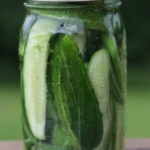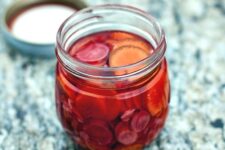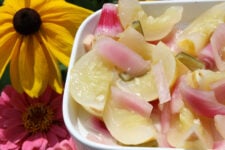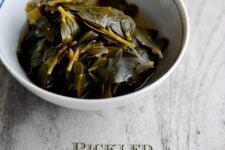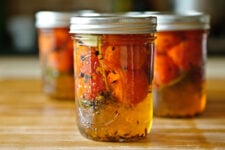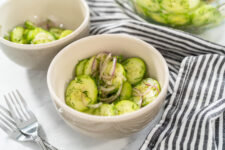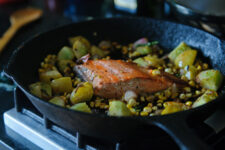Embrace the art of lacto-fermentation with this simple pickle recipe. Fresh from the garden, cucumbers and dill meet farmer’s market garlic scapes for a tangy, nutritious treat.
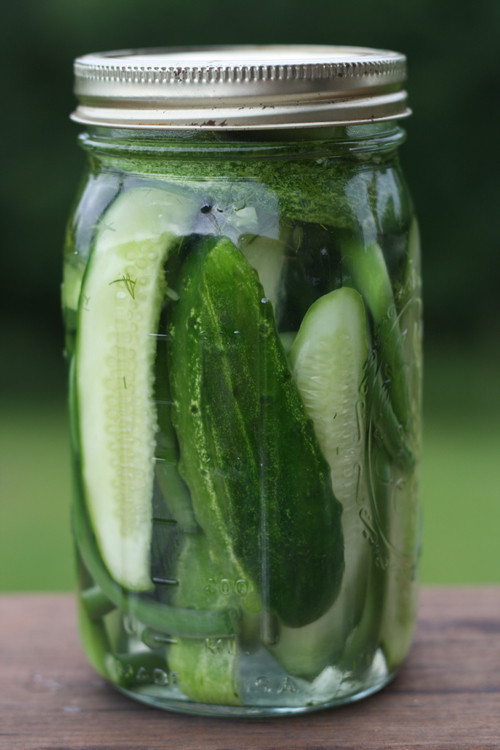
Here is a super easy pickles recipe featuring organic seasonal ingredients.
The cucumbers and the dill in this pickled cukes and garlic scapes recipe came from my garden, and I picked up the garlic scapes at my local farmer’s market (next year I’ll grow my own).
If you aren’t already acquainted with garlic scapes, they are the funky curly green tops that grow out of garlic bulbs. I add them to stir-fries and use them to make pesto, and I also enjoy them in lacto-fermented pickles.
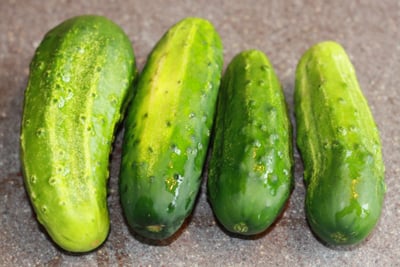
If you didn’t catch my recent post about making sauerkraut, you might not know what lacto-fermentation is (or that I am kind of obsessed with the process).
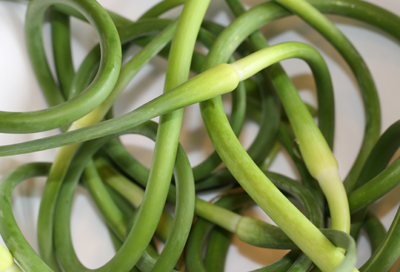
If you aren’t familiar with it, lacto-fermentation is the act of creating a lactic-acid rich environment that enables the natural preservation of certain foods. Lacto-fermentation also makes these foods more nutritious (it increases their vitamin content) and more digestible (it fosters the growth of natural probiotics). Lacto-fermenting is also referred to as “culturing” foods.
I first learned how to make lacto-fermented vegetables from the book Nourishing Traditions by Sally Fallon.
Three of my other favorite references on this subject are Full Moon Feast: Food and the Hunger for Connection, Wild Fermentation: The Flavor, Nutrition, and Craft of Live-Culture Foods
, and Preserving Food without Freezing or Canning: Traditional Techniques Using Salt, Oil, Sugar, Alcohol, Vinegar, Drying, Cold Storage, and Lactic Fermentation
.
Vegetables are easily lacto-fermented/cultured by mixing them with a salt water solution and allowing them to sit in an air-tight container (a glass mason jar works well) at room temperature for several days before moving them to the refrigerator.

This is how foods like traditional pickles, sauerkraut, and kimchi came to be, and while I sometimes do purchase store-bought versions of these foods, I very much enjoy keeping the lacto-fermentation tradition alive in my kitchen.
Pickled Cucumbers & Garlic Scapes
Equipment
- 1 one-quart mason jar very clean with screw-top lid; run through the dishwasher before using to ensure it is sterilized
Ingredients
- 4-5 cucumbers Kirby or some other pickling variety
- 5 garlic scapes
- 3 tbsp fresh dill
- 1 tbsp salt
- 1 cup filtered water
Instructions
- Wash the cucumbers. Snip off the very ends and slice them lengthwise. Cut off the tops and bottoms of the garlic scapes and then cut them into pieces several inches long.
- Place cucumbers and garlic scapes into a 1 qt. wide-mouth mason jar. Mix salt and water in a small bowl and pour into the jar. Add additional water so that the vegetables are completely covered and the liquid is about 1 inch below the top of the jar. Screw the top on the jar tightly and allow to sit at room temperature for three days.
- After this time, go ahead and open the jar. The liquid should be pretty fizzy, which means the lacto-fermentation was successful. If there is any type of "off smell", discard and start again (I'm mentioning this as a caution, but also want to mention that I have been lacto-fermenting for years, and I have never had anything go wrong).
- Go ahead and taste a pickle. The cucumbers should have a nice garlicky tang from the scapes, and they should be pleasantly "dilly". You can eat the pickled garlic scapes too, of course, but they are strong.
- Once opened, move your jar to the refrigerator for storage. Lacto-fermentation will continue in the colder temperature, but at a much slower rate, and the garlic scapes should mellow a bit over time.

